The Bhaja Caves to Lohagad Fort trek might seem like a stretch, but we’re glad we took the chance. This scenic route is one of Maharashtra’s most underrated hikes, revealing the raw, untouched beauty of the Sahyadris. Mostly flat, the trail lets you walk at your pace — with just enough rugged corners to test your stamina.
Whether you’re a seasoned hiker or a weekend traveller looking for something beyond the usual tourist spots, this short hike offers a rewarding experience. With every step, you move through layers of history and landscape. This trek allows you to move from ancient Buddhist caves to a towering Maratha hill fort.
The route is quiet and scenic making it perfect for those craving solitude and slow travel. Plus, hiking outdoors boosts both mood and metabolism, so it’s a win for body and mind.
The best part about the Bhaja Caves to Lohagad Fort trek is that it fits beautifully into any Lonavala getaway. The trek takes just about 90 minutes or slightly more if you linger with your camera, and starts right where the Bhaja Caves trail ends.
This means you won’t need extra transport, guides, or planning. Whether you’re visiting for a day or a weekend, adding this trail gives your itinerary a sense of adventure.
Route Overview: What to Expect on the Trail
This trail isn’t about speed—it’s about soaking in the Sahyadris one step at a time. The route from Bhaja Caves to Lohagad Fort covers around 4 kilometres and takes 90 to 120 minutes to cover. With all the photography stops and water breaks, we were able to complete this trek in 120 minutes.
The terrain is a mix of rocky patches, grassy slopes, and shaded village paths. You’ll descend from the caves onto a natural trail that eventually merges with the main Lohagad-Visapur trek road. This road further guides you toward the fort’s base village.
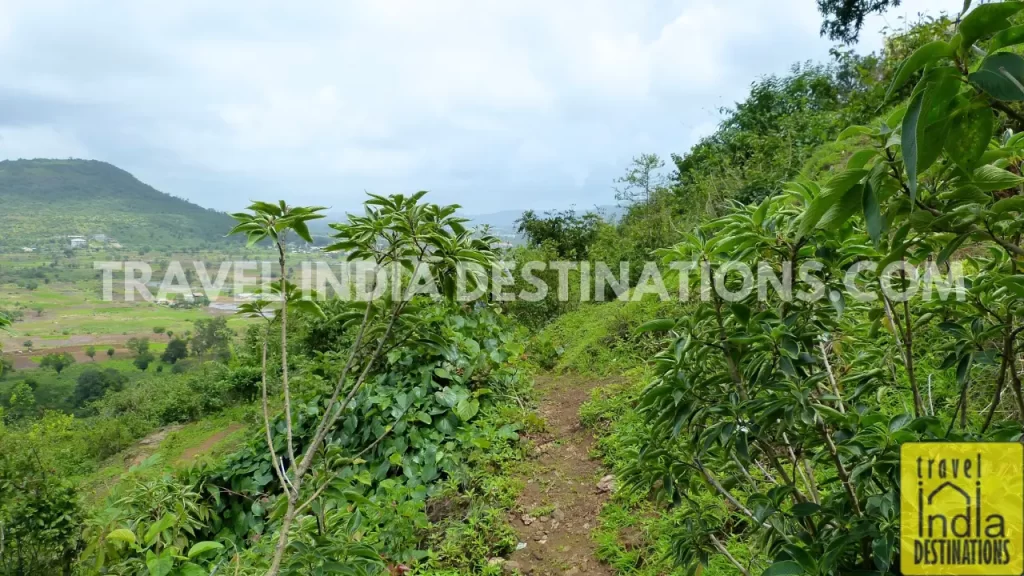
During the monsoon season, you may want to avoid taking the risk of descending via this muddy, unpaved slope. Instead, take the stone steps back down from Bhaja Caves to reconnect with the main Lohagad-Visapur trek road.
While the main trek road is paved for light vehicle traffic, it provides more grip and stability in the rain. Best of all, it leads you directly to the Lohagad base village— so no chance of getting lost.
The Descent: Connecting to the Lohagad-Visapur Trek Road
Now that we were done exploring Bhaja Caves, Sarah and I were in no mood to retrace our steps down the stone stairway. We both were focused on the time we had and the determination to reach the fort as quickly as possible.
We followed a few trekkers who veered off the main path, taking a rugged, unpaved trail that dipped into the hills. It felt spontaneous and slightly risky, perhaps—but the weather was on our side.
Monsoon clouds hovered overhead, teasing us with the promise of rain, while bright sunlight filtered through, casting dramatic shadows on the landscape. We both were dearly missing our sunscreen lotion then.
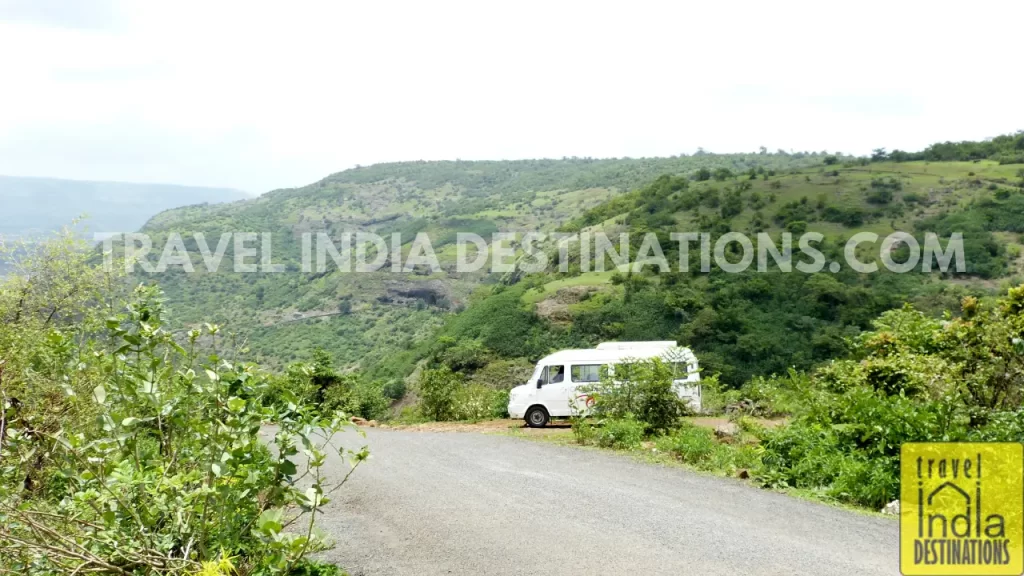
The descent led us to the main Lohagad–Visapur Trek road—a paved path often used by hikers and the occasional vehicle. It felt like we had stumbled onto a lesser-known backdoor trail into the heart of the Sahyadris.
Midway, we paused near a bend where a group of hikers had settled in a green space by the roadside. We joined them briefly, refilled our bottles, enjoyed the panoramic views and caught our breath.
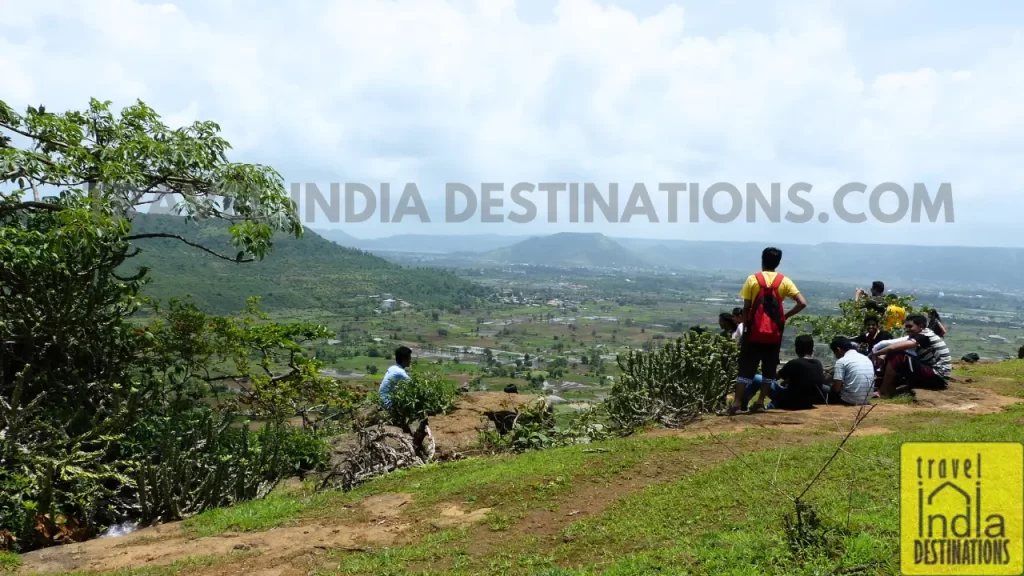
From there, the trail teased us with distant views of Lohagad’s bastions – fort walls rising like sentinels in the mist—yet the fort itself still felt a world away.
However, both Sarah and I kept walking, having our conversations which made the journey easier. The road offered more than just a path forward—it gifted us postcard-perfect moments.
We saw cattle grazing freely on the hillsides, birds singing in hidden trees, and now and then, a car would go past, reminding us we weren’t entirely off the grid.
Khind Rasta Walk: A Trail Through Lush Green Silence
Just as we neared the Khind Rasta—a mountain pass that gently curves through the Sahyadris—the landscape subtly shifted. The greenery deepened, the road narrowed, and a hush seemed to fall over the trail.
Both Sarah and I enjoyed our first glimpse of the mighty Visapur Fort in the distance, its silhouette etched against the sky.
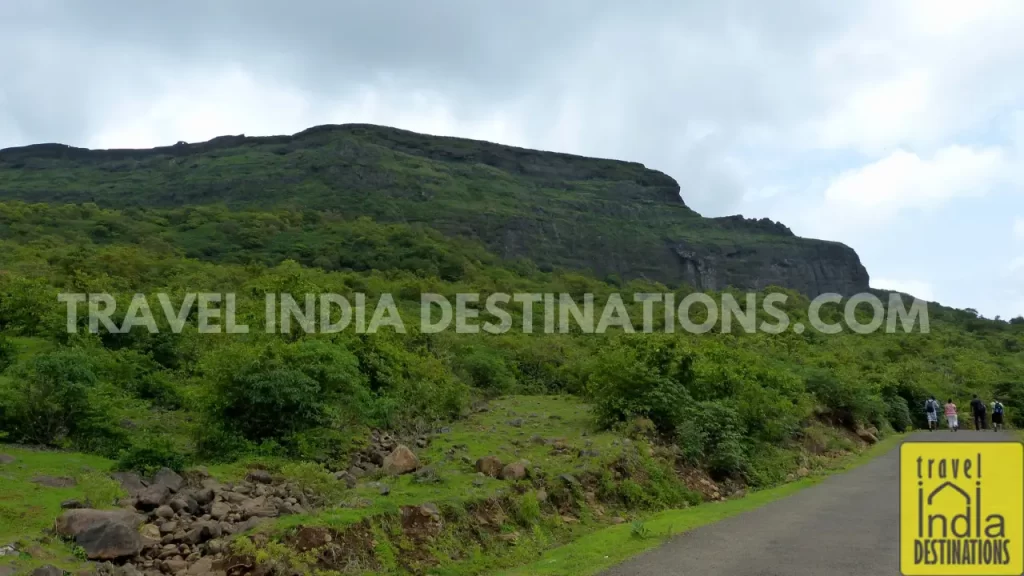
A certain stretch of the road felt particularly secluded, hemmed in by dense foliage on both sides. For a moment, the closeness of the jungle made the path feel a bit uncertain, almost too quiet.
But just as quickly, the trail opened up again, offering a welcome view near the base of Visapur Fort. Some of the hikers ahead of us broke away from the road, and took the Visapur Fort road.
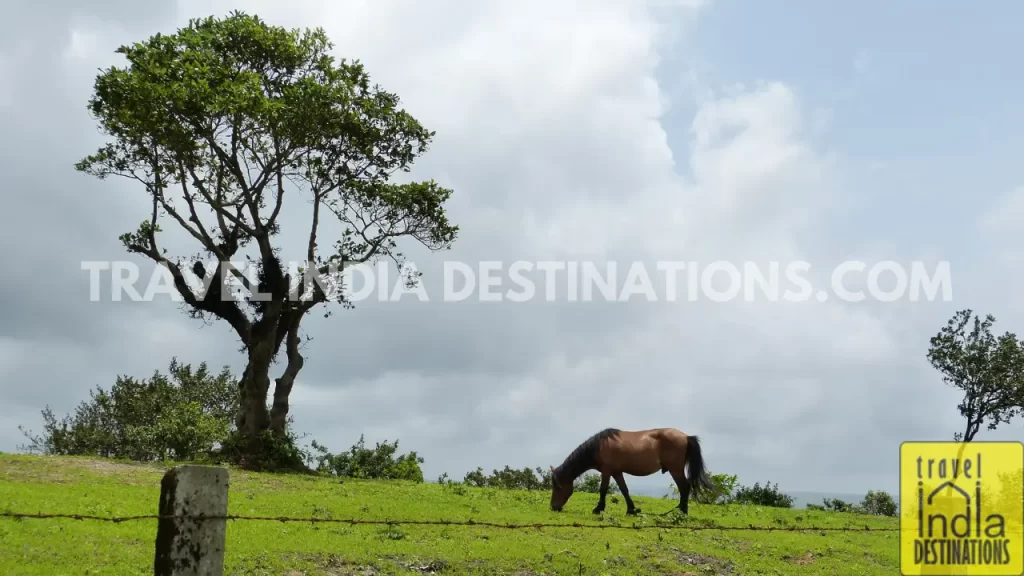
However, for us, the path continued straight, quieter now, with cows and ponies grazing lazily, unfazed by the passing hikers. The breeze picked up, rustling the tall grasses and carrying with it the earthy scent of monsoon-soaked soil.
Arrival at Lohagad Base Village: The Fort’s Majestic Welcome
After weaving through the shaded Khind stretch, the landscape opened and we enjoyed the first commanding view of the Lohagad Fort. It was quite a scenic route with the triangular Visapur Fort rising behind us and the majestic Lohagad Fort standing tall in front.
The contrast of these two historic giants—one receding into the distance, the other looming ahead—framed the perfect finale of our hike.
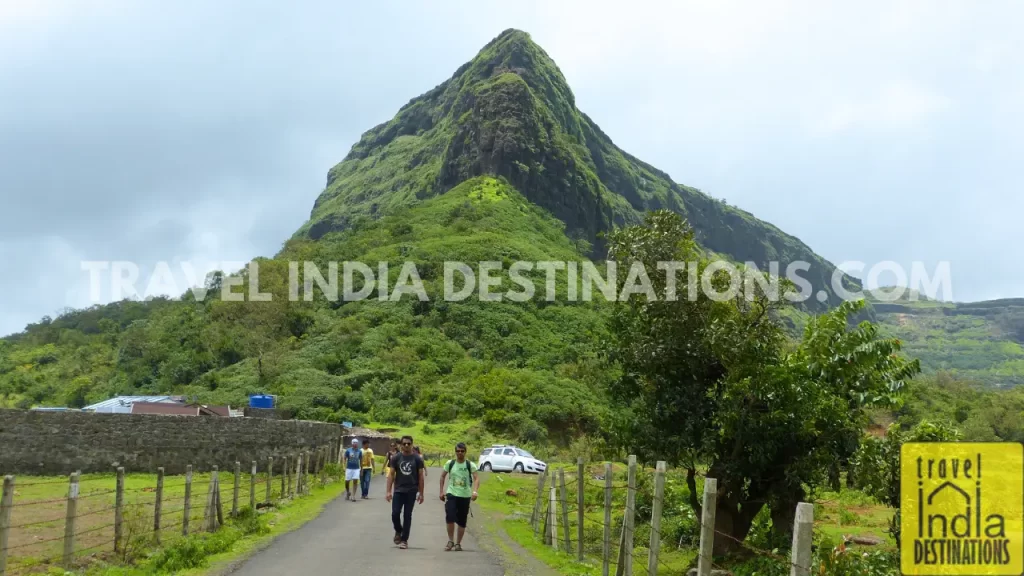
The village at the base had a quiet rhythm of its own. A few modest stalls offered lemon juice, soft drinks, water bottles, and the traditional vada pav and corn on the cob (bhutta) – simple comforts for weary hikers.
Troops of monkeys appeared, going about their chaotic daily business. Some casually swinging through trees, others boldly attempting to snatch snacks from unsuspecting hikers. It added a dose of wild unpredictability to the otherwise peaceful setting.
There are toilets available for both male and female hikers at the Lohagad Fort village. So, we would recommend that you take your time to freshen up and refuel your energy at the base village, before you start climbing the Lohagad Fort.
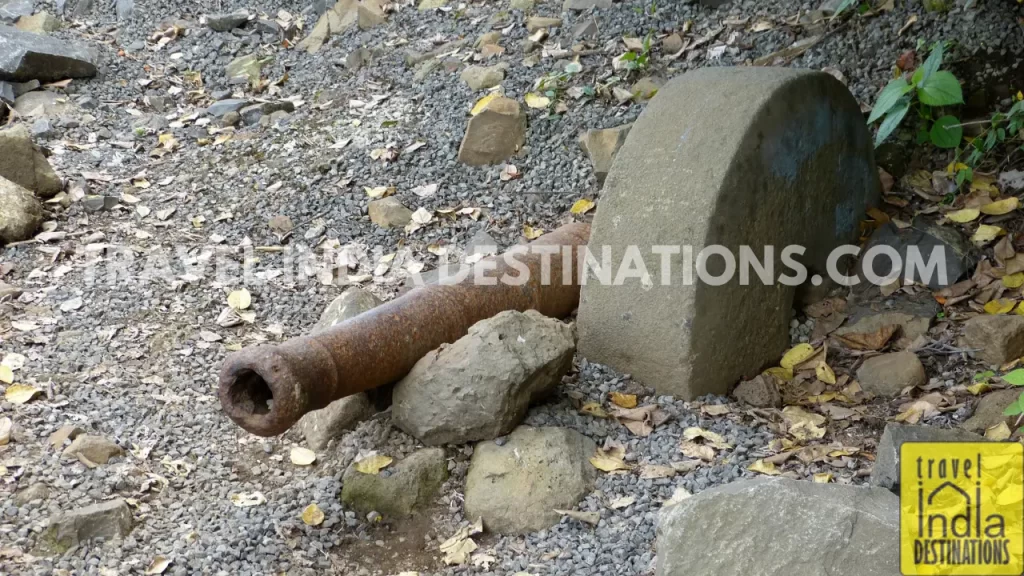
At the base of Lohagad, history reveals itself casually. Within the first few steps of the climb, we noticed small cannons and scattered relics. These were the silent reminders of the fort’s military past. These artefacts, resting against moss-covered walls, offered a teaser of what lay ahead.
Scaling Lohagad Fort: The Grand Finale Awaits
For those feeling the fatigue of this nearly 4-kilometre hike, the base village offers a natural pause. However, in reality, arriving here is only the beginning of the final and most thrilling chapter of this journey.
If hiking isn’t your thing, that’s fine, this entire route can be done by car. The road from Bhaja Caves Lonavala to Lohagad Fort is motorable, and there’s a parking area near the base village.
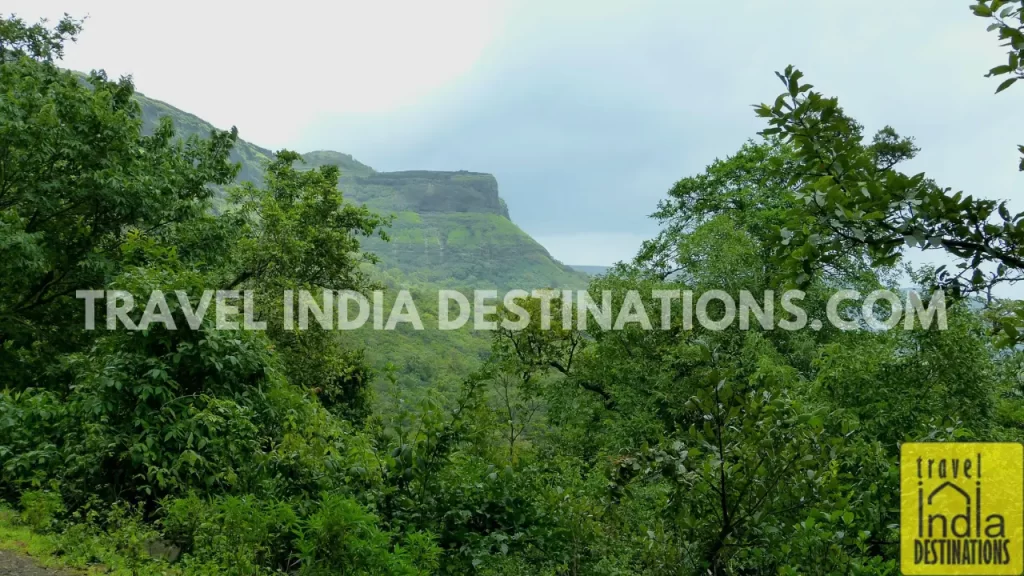
But whether you arrive on foot or by vehicle, Lohagad still demands one last push—an uphill climb that’s steep, scenic, and worth the effort.
Want to complete the journey? Don’t miss our Lohagad Fort trek experience – where we share our insights, images and details to help you plan yours.
Conclusion: A Journey Worth Every Step
The Bhaja Caves to Lohagad Fort trek offers more than just an adventure; it immerses you in the raw, untouched beauty of the Sahyadris, blending history, nature, and a personal journey into one. It is among the best places to visit in Lonavala for those seeking outdoor adventure.
Whether you’re a seasoned hiker or someone looking for a peaceful escape into nature, this hike promises a lovely adventure for sure. With its easily accessible route and minimal time commitment, it’s an ideal addition to any Lonavala itinerary.
So, lace up your hiking boots, breathe in the crisp mountain air, and embark on an unforgettable journey across this scenic landscape.
17 comments
Thank you Sahrukh! I am so enjoying your tale of adventure. Reminds me of our fun in Costa Rica! Wish I could have been there. Everything is so vibrant and brautiful. There are many little “toadside” stands like your shack of hope along the roads in CR. They sell fruits, veggies, fried plantains and sometimes candies s wrll as bottled water and sodas. Even in the remotest mountain areas tou find them. I bet you were so hlad yo see that one. Sahck of Hope indeed. I look forward to your next installment. 😊👍
Thanks Cheryl for the comment.
I am so sorry for all the typos. Gee. Cell phone. 😞
No issues Cheryl. 🙂 You took time to read and comment that’s all I want.
I love these pictures. This is “hiking” Sharukh and I am glad you take the time to capture the photos and share them with us. I always enjoy reading these posts.
Well, the word hiking is not used here commonly, so majority use the word trekking. I read the difference between the two and realized that you’re right. I have changed the title of both the posts. Thanks for the information. I am glad you love the pictures. I said yes to this trip because I wanted some great shots of the area. Unfortunately, it wasn’t raining. Had it rained that day, the pictures would’ve been more spectacular with mists and clouds all around.
Haha – it’s funny (but I understand) to see someone write “unfortunately it wasn’t raining” after going on a hike.
Rain would have made our ‘hike’ bit difficult, but the misty effect would have been lovely. I’ve been here at such times and let me tell you there’s so much fog and mist around you can only see what’s few steps ahead of you, rest is all under the white misty blanket.
I’d love to do that walk!
Sure. I will take you here the next time you’re here in Mumbai.
LOL! Thanks!
This looks amazing– would love to do this hike next time I’m in Mumbai. Thanks for sharing, Sharukh, and sorry about the late comment– my back has been killing me.
Take care and whenever you’re in Mumbai, do let me know.
Amazing photos what an experience thanks for sharing.
Thanks for checking out the pictures. Yeah, we had a great time. Do check out the other parts too.
Yes will do. It’s nice to voyage to India via your blog:)
Its my pleasure to be the host of your virtual trip to India.